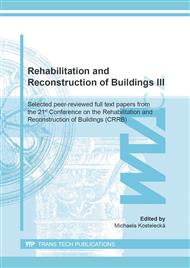[1]
J. Boháčová, S. Staněk, Stanislav and M. Vavro: Possible Aplications of Alkali-Activated Systems in Construciton, Transactions of the VŠB – Technical University of Ostrava, No. 2, 2012, Vol. XII, Civil Engineering Series.
DOI: 10.2478/v10160-012-0012-8
Google Scholar
[2]
T. Bakharev, J.G. Sanjayan and Y.-B. Cheng: Resistance of alkali-activated slag concrete to carbonation, Cement and Concrete Research, Vol. 31(2001), Issue 9, pp.1277-1283.
DOI: 10.1016/s0008-8846(01)00574-9
Google Scholar
[3]
P. Awoyera and A. Adesina: A critical review on application of alkali activated slag as a sustainable composite binder, Case Studies in Construction Materials, Vol. 11 (2019), e00268.
DOI: 10.1016/j.cscm.2019.e00268
Google Scholar
[4]
J. Zhang, C. Shi and Z. Zhang: Carbonation induced phase evolution in alkali-activated slag/fly ash cements: The effect of silicate modulus of activators, Construction and Building Materials, Vol. 223 (2019), pp.566-582.
DOI: 10.1016/j.conbuildmat.2019.07.024
Google Scholar
[5]
T. Luukkonen, Z. Abdollahnejad, K. Ohenoja, P. Kinnunen and M. Illikainen: Suitability of commercial superplasticizers for one-part alkali-activated blast-furnace slag mortar, Journal of Sustainable Cement-Based Materials, Vol. 8(2019), Issue 4, pp.244-257.
DOI: 10.1080/21650373.2019.1625827
Google Scholar
[6]
M. Nedeljković, B. Ghiassi, S. van der Laan, Z. Li, and G. Ye: Effect of curing conditions on the pore solution and carbonation resistance of alkali-activated fly ash and slag pastes, Cement and Concrete Research, Vol. 116 (2019), pp.146-158.
DOI: 10.1016/j.cemconres.2018.11.011
Google Scholar
[7]
S.O. Gade, B.B. Alaca, and M.G.R. Sause: Determination of Crack Surface Orientation in Carbon Fibre Reinforced Polymers by Measuring Electromagnetic Emission, Journal of Nondestructive Evaluation, Vol. 36 (2017), Issue 2, art. no. 21.
DOI: 10.1007/s10921-017-0403-y
Google Scholar
[8]
M. Matysik, M. Korenska and I. Plskova: NDT of freeze-thaw damaged concrete specimens by nonlinear acoustic spectroscopy method, 10th International Conference of the Slovenian Society for Non-Destructive Testing: Application of Contemporary Non-Destructive Testing in Engineering, 2009, pp.317-323.
DOI: 10.5507/tots.2009.024
Google Scholar
[9]
T. Húlan, M. Knapek, P. Minárik, S. Csáki, T. Kaljuvee, and M. Uibu: Assessing the frost resistance of illite-based ceramics through the resonant frequency of free vibration and internal damping, AIP Conference Proceedings, 1866 (2017).
DOI: 10.1063/1.4994495
Google Scholar
[10]
M. Matysik, I. Plskova and Z. Chobola, Z: Assessment of the impact-echo method for monitoring the long-standing frost resistance of ceramic tiles, Materiali in Tehnologije, Vol. 49 (2015), Issue 4, pp.639-643.
DOI: 10.17222/mit.2014.155
Google Scholar
[11]
Plskova, M. Matysik and Z. Chobola: Evaluation of ceramic tiles frost resistance using impact Echo Method, 10th International Conference of the Slovenian Society for Non-Destructive Testing: Application of Contemporary Non-Destructive Testing in Engineering, 2009, pp.333-340.
DOI: 10.1016/0029-1021(73)90133-3
Google Scholar
[12]
M. Matysík, I. Plšková and Z. Chobola: Detection of concrete thermal load time by acoustic NDT methods, Advances and Trends in Engineering Sciences and Technologies III- Proceedings of the 3rd International Conference on Engineering Sciences and Technologies, ESaT 2018, (2019) pp.191-196.
DOI: 10.1201/9780429021596-30
Google Scholar


